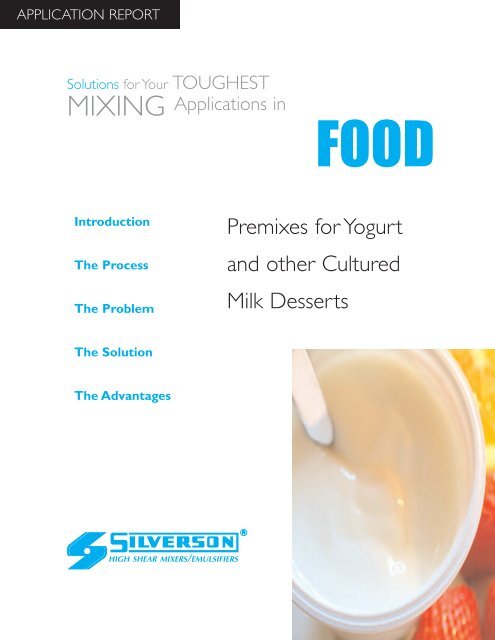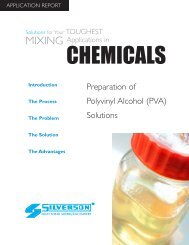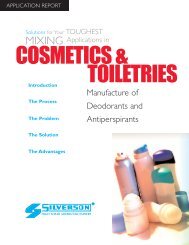Premixes for Yogurt and Other Cultured Milk Products - Silverson ...
Premixes for Yogurt and Other Cultured Milk Products - Silverson ...
Premixes for Yogurt and Other Cultured Milk Products - Silverson ...
You also want an ePaper? Increase the reach of your titles
YUMPU automatically turns print PDFs into web optimized ePapers that Google loves.
APPLICATION REPORTSolutions <strong>for</strong> Your TOUGHESTMIXING Applications inFOODIntroductionThe ProcessThe Problem<strong>Premixes</strong> <strong>for</strong> <strong>Yogurt</strong><strong>and</strong> other <strong>Cultured</strong><strong>Milk</strong> DessertsThe SolutionThe AdvantagesHIGH SHEAR MIXERS/EMULSIFIERS
FOOD<strong>Premixes</strong> <strong>for</strong> <strong>Yogurt</strong> <strong>and</strong> other <strong>Cultured</strong> <strong>Milk</strong> Desserts<strong>Yogurt</strong>s (<strong>and</strong> other cultured milk desserts) are produced by fermentation of milk bythe addition of certain types of bacteria, e.g. Streptococcus thermophilus <strong>and</strong>Lactobacillus bulgaricus. Generally a yogurt is classified as one of two types: Stirred<strong>Yogurt</strong>, which is fermented in bulk be<strong>for</strong>e packing, <strong>and</strong> Set <strong>Yogurt</strong> which is fermented inthe consumer pack (see fig. 1). Be<strong>for</strong>e addition of the starter culture, referred to as“inoculation”, a number of ingredients may be added to the milk:• <strong>Milk</strong> powder <strong>and</strong> other milk solids non-fat (MSNF) such as whey powder (wherepermitted). This contributes to the structure of the yogurt, giving a richer, creamier“mouthfeel”.• Sugar <strong>and</strong>/or sweeteners.• Chocolate crumb <strong>and</strong>/or cocoa powder is added to chocolate <strong>and</strong> chocolate flavorproducts.• Thickening <strong>and</strong> stabilizing agents such as gelatine, pectin, xanthan gum, starch etc.These bind free water in the milk, which helps to prevent whey separation(“syneresis”) <strong>and</strong> can be used to obtain a variety of viscosity <strong>and</strong> texturemodifications.Stirred yogurtPretreatedmilkStartercultureInoculationFermentationCoolingFlavoringFlavoring premixWhole fruit/purée/juice,or essences (e.g. vanilla), sugar,stabilizer, color & flavoringPackingFlavoringPackingFermentationCoolingThe ProcessSet yogurtfig. 1 Basic stages of yogurt productionThe premix of milk <strong>and</strong> other ingredients is prepared in a similar manner <strong>for</strong> bothstirred <strong>and</strong> set yogurts.Typically this is carried out on a continuous basis.The<strong>for</strong>mulation varies according to a number of factors:• Whether the end product is to be sweetened, unsweetened, sugar-free, low fat, fatfreeetc.• The desired modification of the viscosity naturally obtained from the fermentationprocess.• Legislation which controls the use of additives in many countries.A typical premix would be prepared as follows:• <strong>Milk</strong> powder, whey powder or other MSNF is added to the incoming milk, tost<strong>and</strong>ardize the fat <strong>and</strong> dry solids content.• Thickening <strong>and</strong> stabilizing additives may be premixed with the sugar or otherpowdered ingredients. This reduces the <strong>for</strong>mation of agglomerates by separating thegrains, <strong>and</strong> also “weights” the powder to prevent it floating on the surface of the liquid.• The remaining ingredients are added.• The premix is then pasteurized <strong>and</strong> homogenized.
The ProblemA number of difficulties can be encountered when using conventional mixers <strong>for</strong> thisprocess:• Some powders, such as sugar, sink to the bottom of the vessel, while others, <strong>for</strong>example stabilizers, tend to float on the surface of the liquid <strong>and</strong> are difficult to wet out.• Powders must be added at a controlled rate to reduce agglomeration of particles.• <strong>Milk</strong> powder, whey powder <strong>and</strong> cocoa powder are very cohesive, making h<strong>and</strong>ling <strong>and</strong>controlled powder addition difficult.• Premixing of powders increases labor costs <strong>and</strong> process time.• Thickening <strong>and</strong> stabilizing additives have an even greater tendency to agglomerate.Conventional agitators do not produce sufficient shear to break these down.• Potential full yield of some powders is difficult to obtain using traditional methods.• Poor dispersion can lead to partially hydrated material building up on the vessel walls,impairing heat transfer.The SolutionA <strong>Silverson</strong> high shear mixer can overcome these difficulties. This can be achieved byadding an In-Line mixer to the existing process, <strong>for</strong> example at the discharge of aconventional powder/ liquid continuous blending device. For bulk powder dispersion<strong>and</strong> large scale manufacturing, the <strong>Silverson</strong> Flashblend powder/liquid mixing system ismost suitable. These operate on the rotor/stator principle as follows:The high speed rotation ofthe rotor creates apowerful suction whichdraws liquid <strong>and</strong> powderinto the workhead.Centrifugal <strong>for</strong>ce drives thematerials towards theperiphery of the workheadwhere they are subjectedto a milling action in thegap between the rotor <strong>and</strong>stator.The product is <strong>for</strong>ced outthrough the stator as freshingredients enter theworkhead. In a shortmixing cycle all thematerial passes throughthe workhead, acceleratingthe dissolving <strong>and</strong>hydration process.FOOD
The Advantages• Dramatic reduction in mixing times• Significantly better yield than can be achieved by traditional methods• Improved vessel hygiene• Dry premixing is not necessary• Rapid powder absorption minimizes operator input/errorThe batch size, <strong>for</strong>mulation, type of ingredients used <strong>and</strong> the viscosity of the endproduct dictate which <strong>Silverson</strong> product is best suited to individual processingrequirements.High Shear Batch Mixers• Suitable <strong>for</strong> batch sizes up to 500 Gallons• Can be used on mobile floor st<strong>and</strong>s• Small units available <strong>for</strong> R&D <strong>and</strong> pilot scaleproductionPipeline return below fluidlevel to prevent aerationAgitator <strong>for</strong>in-tankuni<strong>for</strong>mity<strong>Silverson</strong>In-LineMixerHigh Shear In-Line mixers• Ideal <strong>for</strong> larger batches• Easily retro fitted to existing plant• Self pumping• Aeration-free• Can be used to discharge vessel or powder/liquidblender• In-Line mixers con<strong>for</strong>m to 3A st<strong>and</strong>ardsPipeline return configuredto minimize air entrainmentCentrifugalPumpVenturiAssemblyAgitator<strong>for</strong> in-tankuni<strong>for</strong>mityPowderFeedHopperIn-LineMixerFlashblend• Ideal <strong>for</strong> larger batches• Capable of incorporating very large volumes ofpowders• Minimized aeration• Minimized cleaning requirements• Minimum operator input required• Easily automated<strong>Silverson</strong> Machines,Inc. 355 Chestnut Street, East Longmeadow, MA 01028Ph: (413) 525-4825 • Fax:(413) 525-5804 • www.silverson.comIssue No. 31FA2In<strong>for</strong>mation contained in this report is believed to be correct <strong>and</strong>is included as a guide only. No warranty is expressed or impliedas to fitness <strong>for</strong> use or freedom from patents. <strong>Silverson</strong> Machinesreserve the right to change product specification without notice.




